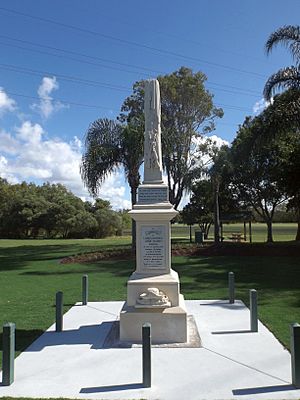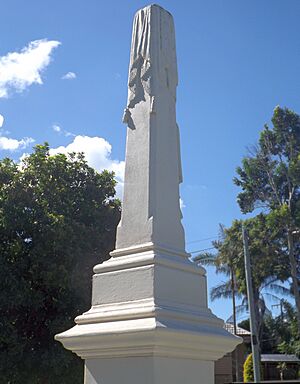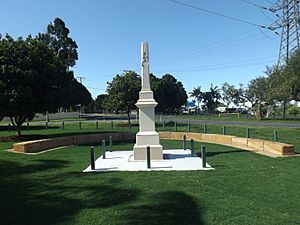Anning Monument facts for kids
Quick facts for kids Anning Monument |
|
|---|---|

War memorial and park, 2015
|
|
| Location | corner of Hemmant and Tingalpa Road and Boonoo Street, Hemmant, City of Brisbane, Queensland, Australia |
| Design period | 1900–14 (early 20th century) |
| Built | 1903 |
| Architect | William Busby |
| Official name: Anning Monument (Boer War Memorial), Hemmant Boer War Memorial | |
| Type | state heritage (built) |
| Designated | 21 October 1992 |
| Reference no. | 600220 |
| Significant period | 1903-(social) 1903 (fabric) 1903–68 (historical) |
| Significant components | memorial surrounds/railings, memorial – obelisk |
| Builders | William Busby |
| Lua error in Module:Location_map at line 420: attempt to index field 'wikibase' (a nil value). | |
The Anning Monument is a special memorial located in Hemmant, Australia. It stands at the corner of Hemmant and Tingalpa Road and Boonoo Street. This monument is listed on the Queensland Heritage Register. This means it is an important historical site.
The monument was designed and built by a stonemason named William Busby. It was completed in 1903. People also know it as the Hemmant Boer War Memorial.
Contents
History of the Anning Monument
The Anning Monument was officially revealed on March 14, 1903. Colonel Thomas Price led the ceremony. The monument was created by William Busby, a skilled stonemason from Toowong, Brisbane.
This stone memorial honors a local hero, Lance Corporal John Harry Anning. He was part of the 5th Queensland Imperial Bushmen. His friends and fellow soldiers helped raise money to build the memorial. They did this after he was killed in action. John Harry Anning was only eighteen years old. He died in Koffiefontein, South Africa, on August 6, 1901.
The monument was first placed at the meeting point of Lytton and Hemmant Roads. But in 1968, a car hit it. So, it was moved to its current spot.
The Anning memorial was built quite early for a war memorial in Queensland. After the First World War, many war memorials were built. But in 1903, when this one was unveiled, they were still very rare.
Australian war memorials show how people felt about their country. They also show the skills of local stonemasons and architects. There are many types of memorials in Queensland today. However, there are only a few that remember the Boer War. Other Boer War memorials in Brisbane include the Caskey Monument (1902) and the Berry and MacFarlane Monument (1902). There is also the South African War Memorial (1919) in Anzac Square.
What the Monument Looks Like
The Boer War Memorial is in a large park in Hemmant. It stands next to a grassy play area. Children's swings are nearby.
The memorial is made of sandstone. It has a base, a pedestal, and a tall, pointed top called an obelisk. It sits on a concrete pad. Metal posts with a metal chain surround it.
The base is a smooth step with a slanted top edge. On top of this is the pedestal's bottom part, called a plinth. It is smooth and has decorative edges. The front of the plinth has a carving of a soldier's hat and a bandolier (a belt for bullets).
Rising from the plinth is the pedestal's main part, called the dado. It is a square pillar with sunken panels on each side. The front panel has a marble plaque with lead letters. This plaque has an inscription about Lance Corporal John Harry Anning. The dado is topped with a large cornice. This is a decorative molding made of several shapes.
The obelisk rises from the pedestal. It also has a small plinth with decorative moldings. Another marble plaque with lead letters is on its front. This plaque has more information about Lance Corporal Anning.
The top of the obelisk has a carved, draped cloth with tassels. This is called a shroud. It is a symbol of death and sadness. Below the shroud are carved crossed rifles. They are tied with a cord and rest on a banner. The banner hangs from a staff with a small crown at the top.
Why the Monument is Important
The Anning Monument was added to the Queensland Heritage Register on October 21, 1992. It met several important rules to be listed.
Showing Queensland's History
War memorials like this one show how Queensland's history has changed. They represent a common event that affected most communities. They also show a time when people felt very proud of their country. This was especially true during and after the First World War. These monuments are unique records of history. They also show what people liked in art and design during that time. The Anning Monument was built very early in the history of war memorials in Queensland.
A Rare Part of Queensland's Heritage
This monument is a special and uncommon example of Queensland's history. It is rare because it was built to remember just one soldier. Most war memorials honor many people.
Key Features of a Memorial
The Boer War Memorial is a very important monument in Queensland. It is one of the few memorials in Queensland that remembers soldiers who died in the Boer War (1899-1902). After the First World War, memorials were built in most towns. But in 1903, when this one was unveiled, they were still quite rare. This memorial at Hemmant shows the main features of a monument built to remember a big historical event. It uses symbols like a shroud, crossed rifles, and an obelisk to do this.
Its Beautiful Design
The Boer War Memorial is important because of its beautiful design and excellent craftsmanship. It shows a high level of skill in its making.
Connection to the Community
This monument has a strong and lasting connection with the local community. It reminds people of a major historical event. It is also a central place for remembering that event.
Association with William Busby
The monument also has a special connection with William Busby. He was a famous stonemason from Brisbane. The Anning Monument is a great example of his work.
See Also
- List of war memorials in Queensland



